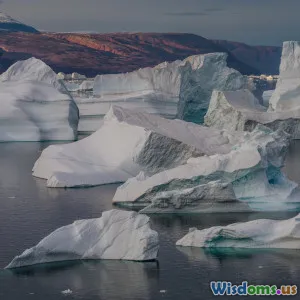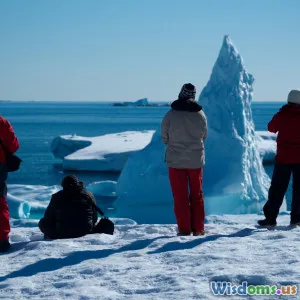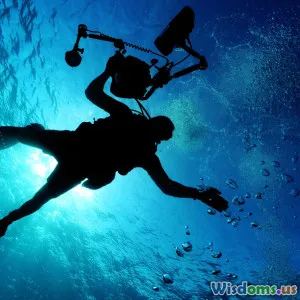
How To Train New Leaders For Arctic Expeditions
16 min read Learn effective strategies to equip new leaders for the challenges of Arctic expeditions. (0 Reviews)
How To Train New Leaders For Arctic Expeditions
Every year, ambitious explorers set out to traverse some of the most hostile environments on Earth—the windswept, ice-bound Arctic. These epic journeys are legendary, but their success hinges on the quality of their leaders. Training leaders for Arctic expeditions demands excellence in resilience, tactical skill, and psychological fortitude. Here’s how newcomers can be transformed into inspiring and reliable Arctic expedition leaders.
Understanding the Stakes: Why Arctic Leadership Demands More

Leadership in the Arctic isn't just about giving orders or plotting routes. Unlike more temperate expeditions, the rapid changeability and unforgiving conditions of the far north amplify every small decision. For instance, a 2023 report from the British Antarctic Survey noted that improperly prepared team leaders were directly correlated with failed objectives and costly search-and-rescue efforts. Leaders are responsible not only for scientific or adventure goals but, more critically, the safety and survival of every team member.
Crucial elements include:
- Extreme Cold Management: The Arctic presents dangers like frostbite and hypothermia. Leaders must understand the science behind cold weather survival and preventive health care.
- Isolation & Logistics: With isolation comes logistical nightmares—weather delays, equipment failure, and difficult resupplies are common scenarios.
- Group Dynamics: In close quarters, personality clashes are heightened, and morale is vulnerable. Leaders need an advanced toolkit for interpersonal management and conflict resolution.
These challenges mean traditional leadership training is insufficient. Instead, tailored Arctic-specific leadership programs are essential.
Building the Foundations: Selecting and Preparing Trainee Leaders

The process begins long before boots are on the snow. Selecting and preparing future leaders involves rigorous vetting to ensure both aptitude and attitude.
Key Selection Criteria:
- Psychological Robustness: Can the candidate remain calm under stress, make difficult decisions, and keep morale up?
- Physical Endurance: Arctic expeditions are punishing. Pre-selection fitness tests are intensive, including simulated emergencies like dragging sleds for hours in cold chambers.
- Technical Skills: Familiarity with navigation, ice safety, cold-weather gear, and first aid is mandatory.
Example: Polar Challenge Pre-Assessment
The Polar Challenge, a leading European Arctic training camp, requires all leader candidates to complete a five-day field exam. Candidates traverse 50km per day with fully loaded pulks (sleds), and are evaluated not just on pace, but their communication skills, risk assessments, and team management during high-stress scenarios.
A common takeaway from such pre-selection? Leaders who demonstrate good judgment in gray situations—such as recognizing when to turn back or push on—are more likely to keep their teams safe and effective.
Immersive Arctic Field Training: Simulating the Real Experience

Once selected, prospective leaders are enrolled in extensive, immersive field training. No classroom or online seminar can substitute for the exposure to wind, ice, and relentless cold in the field.
Key Components:
- Navigation & Survival Drills: Trainees practice map-and-compass navigation under whiteout conditions, and learn GPS-based fallback techniques. Field instructors, often experienced guides themselves, inject simulated emergencies without warning—a tent collapse, team injury, or sudden blizzard.
- Campcraft: Leaders must master pitching tents in gales, melting ice for water, managing ration packs, and efficiently running a camp.
- Sledge Handling: Pulling and maneuvering heavy sledges on variable ice requires not just strength but finesse—and leaders train to coach others in these techniques.
Case Study: Yukon Expeditions’ Leadership Simulator
Yukon Expeditions pioneered a program where candidates lead simulated teams of actors role-playing as ornery, tired, or injured crew. The realism—complete with time-limited decision points—exposes leaders’ weak spots and strengths. Feedback is direct, practical, and often eye-opening for trainees.
Mastering Arctic Decision-Making Under Pressure

One of the hallmark skills in an Arctic leader is the ability to make and communicate decisions under extreme pressure. Errors are costly when the environment is unforgiving and response times are measured not in hours, but potentially in days.
Decision Workshop Elements
Modern Arctic leader training features decision-making simulations to develop three core abilities:
- Situational Awareness: Leaders are taught to constantly observe, assess, and anticipate change—such as weather fronts, ice fragility, or team fatigue.
- Prioritization: Quickly distinguishing between urgent, important, and background issues. For instance, is a team member's mild frostnip an immediate priority or should it wait until shelter is reached?
- Communication: Clearly and calmly conveying decisions, especially in emergency scenarios.
Example in Practice
In April 2022, a training simulation by Northbound Institute tasked candidates with responding to a tent fire at 2am during a whiteout. Successful leaders quickly assigned roles, organized safe evacuation, and administered cold-exposure protocols—all under tremendous stress. Post-exercise debriefs showed a 20% improvement in future scenario response times for participants.
Cultivating Leaders Who Foster Resilient, Cohesive Teams

Enduring the extremes isn't just a matter of boldness. Effective Arctic leaders must build resilience in their teams by modeling good morale, empathy, and inclusiveness. The Arctic notoriously exacerbates social friction, so leaders are trained in advanced group dynamics and positive reinforcement.
Core Team-Building Skills
- Pre-Expedition Bonding: Cultural and personality mapping are carried out before the ice trek, allowing leaders to design tent groups and daily routines that suit members’ strengths.
- Routine & Rituals: Leaders implement rituals like shared meals, storytelling sessions, or morning check-ins to maintain engagement and stave off isolation.
- Transparent Decision-Making: The more a team understands the rationale behind tough calls (e.g., weather delays or ration cuts), the more they trust and support their leader.
Example: Scandinavian Expeditions’ Buddy System
Scandinavian training outfits have popularized the “buddy system,” pairing every member for both practical safety and mutual emotional support. Leaders are taught to rotate pairs and monitor these bonds, fostering a sense of care throughout the group.
Technical Mastery: Essential Arctic Skills All Leaders Need

Aside from soft skills, technical mastery is critical. Equipment failure in the Arctic is more than inconvenient—it’s potentially lethal.
Essential Skill Sets
- Navigation
- Mastery of GPS, altimeters, and traditional compass/map navigation are non-negotiable. Leaders must train in equipment troubleshooting and have fallback redundancies.
- On a 2021 Greenland crossing, a leader avoided disaster when an unexpectedly strong solar storm knocked out GPS. Able to switch to orienteering and manual mapping, the group reached safety.
- First Aid & Medical Skills
- Training includes cold injury assessment (frostbite, trench foot, hypothermia) and remote trauma care, such as improvising splints or administering injectable antibiotics.
- The Canadian Polar Training Program involves three-day scenario-based courses taught by paramedics with cold-weather experience.
- Gear Maintenance
- Repairs are doubly challenging when epoxies freeze and plastics become brittle. Leaders have to fashion repairs on-site from minimal supplies. Some programs run gear triage competitions, scoring the speed and durability of field repairs.
- Wildlife Awareness
- Encounters with polar bears or other Arctic fauna are rare but high risk. Leaders are instructed to use deterrents responsibly and to manage group camps in a manner that minimizes attractants.
Mental Health Strategies for Endurance and Recovery

It’s no secret: The relentless Arctic night, physical fatigue, and constant low-level stress take a toll on mental health. Modern leadership training now puts as much weight on psychological preparedness as on physical ability.
Techniques and Approaches
- Structured Downtime: Leaders must manage energy and stress cycles, inserting busy routines with calming activities to prevent burnout.
- Mentorship: Trainees are paired with experienced Arctic veterans, who provide guidance and share coping strategies from previous expeditions.
- Normalizing Challenges: Openly discussing psychological hurdles—insomnia, anxiety, moments of doubt—empowers leaders and teams alike. Mental health check-ins become part of daily schedules.
Recent Insights
A research survey published in 2023 by the University of Oslo found that leader-initiated mental health interventions reduced overall incident rates of expedition drop-outs by more than 40%. The study credited robust pre-expedition mental health sessions and daily group debriefs as key factors.
Leveraging Technology Without Losing Arctic Wisdom

While the legendary explorers struggled with compass and sextant, today’s leaders benefit from advances in technology like satellite communication, advanced clothing insulation, and real-time weather feeds. However, over-reliance on tech is risky; batteries drain quickly in subzero temperatures, and devices can fail.
Balancing Tools and Tradition
Effective training encourages leaders to:
- Use Satellite Tech Combine with Redundancy: Portable solar panels, backup battery packs, and manual signaling methods ensure vital comms are never lost.
- Integrate Native Knowledge: Invaluable insights, like reading subtle snow color changes to avoid thin ice—a skill Inuit guides have used for centuries—are incorporated into Western curricula.
Notable Example
During a 2019 Norwegian expedition, a severe geomagnetic event cut all sat-phone links. The veteran leader, trained in both modern tech and traditional ice-reading, guided the team 30km to a safe zone by observing sastrugi (wind-sculpted snow ridges) patterns and using aurora movement for direction when compasses faltered.
Continuous Feedback and Post-Expedition Analysis

Leadership development never ends at the journey's close. Rigorous, structured debriefs—sometimes continuing for weeks after team extraction—capitalize on hard-earned experience.
Feedback Mechanisms
- 360-Degree Reviews: Team members and fellow leaders share anonymous, candid feedback. What worked? What failed? Organizations like the International Polar Foundation use this method to tailor next-generation programs.
- Performance Journaling: Leaders maintain detailed diaries, logging decisions and their outcomes. Reviewing these journals during group sessions cements lessons and surfaces patterns.
- Case Study Presentations: Presenting lessons learned to other trainees and aspiring leaders is now standard—public reflection ensures knowledge transfer and cultivates humility and shared learning.
Empowering the Next Generation of Arctic Leaders

As the polar regions become more accessible due to changing climate and enhanced support, the importance of highly trained, psychologically resilient, and technically competent leaders only grows. Optimizing the training of new Arctic expedition leaders preserves not just the safety of intrepid teams, but also the spirit of discovery that drives humanity northward.
By embracing immersive field experience, resilient teamwork, advanced technical training, modern wellness strategies, and sharing the lessons learned, expeditions not only endure but thrive. The enduring magic of the Arctic demands respect—and the next generation of leaders, properly prepared, will rise to meet the challenge.
Rate the Post
User Reviews
Other posts in Expedition Planning
Popular Posts














